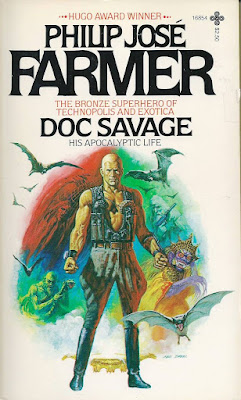Book Review: 'Doc Savage: His Apocalyptic Life' by Philip Jose Farmer
'Doc Savage: His Apocalyptic Life' first was published in 1973 as a hardcover from Doubleday. Subsequent paperback editions were published by Bantam Books in 1975, and Playboy Press in July, 1981 (269 pp., above, cover illustration by Ken Barr). All editions of DS:HAL are out of print, and used copies in good condition increasingly are quite expensive (e.g., $100 for the 1973 hardback).
The nostalgia craze that swept American popular culture from the 1960s to the early 1980s arguably started with Doc Savage, when, in the fall of 1964, Bantam Books issued the paperback reprint of the very first novel in the franchise, 'The Man of Bronze.'
The series sold very well and sparked a revival of interest in prewar media; just a year later, Jules Feiffer published 'The Great Comic Book Heroes,' and in 1970, Tony Goodstone published 'The Pulps.' Other paperback reprints of 1930s heroes, such as G-8 and his Battle Aces, the Avenger, Conan the Barbarian, and the Shadow, followed in the footsteps of the Savage franchise.
DS:HAL therefore is very much a product of the nostalgia craze, and at the time it was published, Philip Jose Farmer was the biggest fanboy of the pulp heroes.
The term 'fanboy' didn't exist in 1973, but if it had, it certainly would have applied to Farmer. His 1972 book, 'Tarzan Alive: A Definitive Biography of Lord Greystroke' was the ultimate paean to Tarzan and by extension, other heroic figures in what Farmer termed 'poplit' (i.e., popular literature).
To write DS:HAL, Famer contacted Jack Cordes, who had a collection of every issue of the 181 original Street and Smith magazines published from 1933 to 1949. Farmer sat down with the Cordes collection and read each issue, taking notes and framing a narrative as he went.
For additional insights into Lester Dent and his writing career, Farmer also interviewed Dent's widow, Norma Gerling Dent, at her home in La Plata, Missouri.
DS:HAL presents its nostalgia component in its very first chapter, 'The Fourfold Vision,' in which Farmer reminisces about buying the very first issue of 'Doc Savage' magazine on a cold February day in 1933 in Peoria, Illinois. Farmer's love for Doc and the Fabulous Five was sparked that day, and stayed with him the rest of his life.
The narrative then moves into an in depth-analysis of all aspects of the Doc Savage franchise. There is a chapter on the mysterious origins of Doc, and his kinship with other poplit heroes. Analyses also are provided of the office and laboratory space atop the Empire State Building; each member of the Fabulous Five, and Pat Savage. There are chapters on the most prominent villains, and Doc's gadgets and technologies.
In
'Tarzan Alive' Farmer introduced a quintessential fanboy product: the
'Wold Newton' universe, a sort of genealogical chart / family tree of
prominent poplit characters. The Wold Newton universe suffuses Farmer's
treatment of Doc Savage in the pages of DS:HAL. Indeed, the longest chapter
in the book, 'The Fabulous Family Tree of Doc Savage,' is a lengthy
recitation of the individuals comprising the said tree, from Natty
Bumpo, to Sam Spade, to Kilgore Trout. The esoteric nature of Farmer's
Wold Newton universe prefigures the essays Alan Moore published in his
'League of Extraordinary Gentlemen' comic books, essays in which myriad
characters and places from imaginative literature are incorporated in a
complicated 'metaverse.'
The main 'literary' messaging in DS:HAL is interesting. Farmer argues that the Doc Savage franchise, E. E. Smith and his 'Lensmen' stories, and William Burroughs's 1964 novel 'Nova Express,' share kinship as sci-fi works reliant on confrontation with apocalyptic events. Doc Savage is the epitome of the apocalyptic hero; his adventures involve all manner of strange and terrifying threats to the world order, and only a hero of Doc's skill and stature can prevent extinction. In this regard, Savage and the Fabulous Five are counterparts to Burroughs's Nova Police. In presenting this argument, Farmer even adopts the 'cut-up' prose used by Burroughs.
This is a bit contrived, but then again, in 1973 everyone involved in science fiction was adamant that Burroughs was, in fact, a sci-fi writer and thus an example of the genre transcending its pulp lineage into the world of 'speculative fiction.'
Who will want a copy of DS:HAL ? Likely the same dwindling cohort of Baby Boomers who would be interested in other titles dealing with the pulp heroes and the nostalgia boom of 50 years ago. I see few indications in 2025 of people (especially young men) interested in reading pulp hero fiction, much less reading any fiction at all. However disappointing the idea may be, sixty years after it began, the pulp hero revival has run its course and is fading from memory..............














.jpg)















